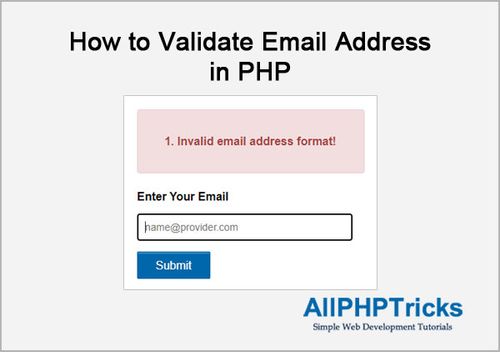As the backbone of modern communication, email addresses play a pivotal role in web applications, ensuring effective user registration, engagement, and communication. However, handling email addresses in PHP requires a deep understanding of email validation syntax to prevent vulnerabilities and ensure data integrity. In this comprehensive guide, we delve into the world of email validation in PHP, exploring various techniques and best practices that will elevate your web development skills.
The Significance of Email Validation
Before we dive into the technicalities, let's understand why email validation is crucial:
Data Quality: Email validation guarantees that the data your application collects is accurate and reliable, reducing the risk of errors and duplicate entries.
Security: Proper email validation is a crucial part of web application security. It prevents common vulnerabilities like SQL injection and Cross-Site Scripting (XSS) attacks.
User Experience: Validating email addresses during registration ensures a smooth onboarding process for users, reducing frustration and abandoned sign-ups.
Understanding Email Validation in PHP
1. Using Regular Expressions (Regex):
Regular expressions are a powerful tool for email validation in PHP. They allow you to define specific patterns that a valid email address must follow. Here's a basic regex pattern for email validation:
$pattern = "/^[a-zA-Z0-9._-]+@[a-zA-Z0-9.-]+\.[a-zA-Z]{2,4}$/";
This pattern checks for the standard structure of an email address, including the "@" symbol and a valid domain.
2. PHP Filter Functions:
PHP provides filter functions like filter_var() to validate email addresses. The FILTER_VALIDATE_EMAIL filter is specifically designed for this purpose. Here's an example of how to use it:
$email = "[email protected]";
if (filter_var($email, FILTER_VALIDATE_EMAIL)) {
echo "Valid email address.";
} else {
echo "Invalid email address.";
}
3. Avoiding Common Pitfalls:
Email validation can be tricky due to the diversity of email addresses in use today. Here are some common pitfalls to avoid:
- Don't rely solely on regex patterns; they may reject valid email addresses.
- Be aware of internationalized email addresses (IDNs) and support Unicode characters.
- Consider case insensitivity; email addresses are not case-sensitive.
- Keep your validation logic up-to-date, as email standards may evolve.
Best Practices for Robust Email Validation
Use PHP Filters: Whenever possible, leverage PHP's built-in filter_var() function with FILTER_VALIDATE_EMAIL. It's a reliable and efficient method for email validation.
Regular Expressions with Caution: If you opt for regex, be cautious. Use established patterns, and thoroughly test them to ensure they cover edge cases without blocking valid addresses.
Check MX Records: To verify the existence of the domain, consider performing a DNS MX record lookup. It confirms whether the domain can receive emails.
Consider Libraries: If you need advanced email validation, consider using third-party libraries like "egulias/email-validator" for PHP.
User-Friendly Error Messages: When validation fails, provide clear and user-friendly error messages to help users correct their input.
Commonly Asked Questions
1. Is regex the best method for email validation in PHP?
Regex can be effective but has limitations and may not cover all edge cases. PHP filters, like FILTER_VALIDATE_EMAIL, are generally more reliable and easier to use.
2. Should I validate email addresses both on the client and server sides?
Yes, validating on both sides is a best practice. Client-side validation enhances user experience, while server-side validation ensures data integrity and security.
3. Can email validation ever be 100% foolproof?
No, because the email landscape is constantly evolving. However, with best practices and continuous updates, you can achieve a high level of reliability.
4. How often should I update my email validation logic?
Regularly review and update your validation logic to adapt to changing email standards and emerging patterns.
5. Are there any PHP libraries for advanced email validation?
Yes, consider using libraries like "egulias/email-validator" for comprehensive email validation in PHP.
Conclusion
Email validation is a critical aspect of web application development, ensuring data accuracy, security, and user experience. In this guide, we've explored various methods, including regex patterns and PHP filters, to help you master email validation syntax in PHP. By following best practices and staying vigilant, you can enhance the reliability of your web applications and provide users with a seamless experience while safeguarding their data.



